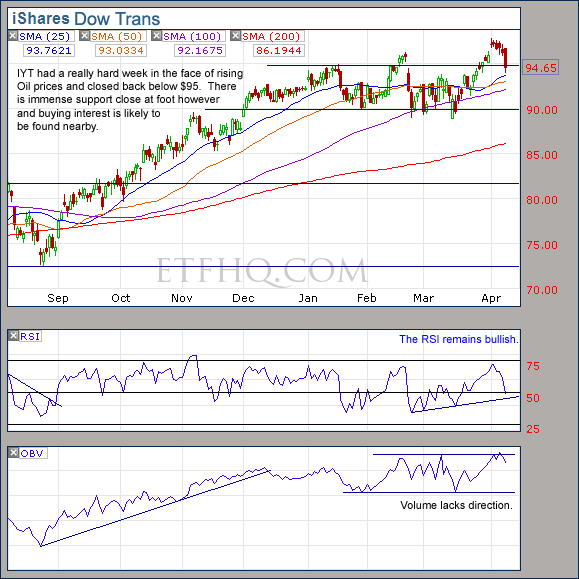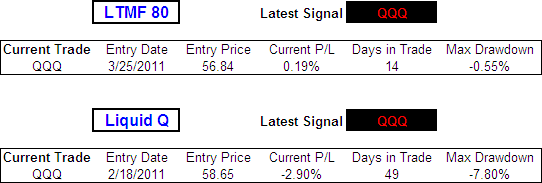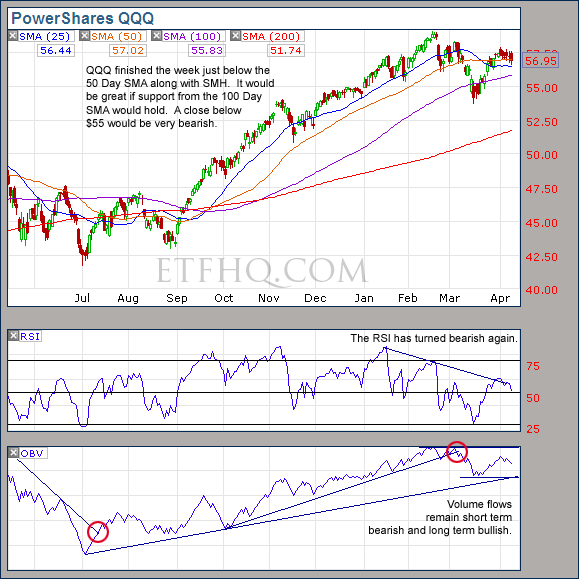April 11, 2011 – 08:55 am EDT
There were signs last week that short term weakness and a test of support was on the way before new highs. It now appears as though that weakness has begun and a close observation of buying interest around support will be necessary. But are we indeed seeing profit taking or have we underestimated the bears? Lets take a closer look…
**** Welcome to this weeks new readers. Thanks for everyone that spread the word!
.
ETF % Change Comparison
.

If SMH had had another bad week then it would have majorly deflated the bullish argument. Instead we see SMH and IWM up over 7% from their low 23 days ago and SMH again leading the market higher. Hopefully IYT doesn’t have a repeat performance this coming week as participation from the transports is necessary for the market to maintain support.
Learn more – ETF % Change Comparison
.
![]()
.
A Look at the Charts
.

Very important support at $130!
.
Would really like to see 100 Day SMA support hold.
.

SMH really has the power to ignite or extinguish the broad market. A little bit of buying here and she will be off.
.

Loving the volume on IWM. Not what you are likely to see at a market top.
.

IYT is back below $95 and lacks direction. Looking for support nearby.
.
![]()
.
OM3 Weekly Indicator
.

The OM3 Indicator suggests a general lack of direction from the market.
Learn more – The OM3 Indicator
.
![]()
.
TransDow & NasDow
.

TransDow – The Dow has regained dominance over the Transports and as a result the TransDow has moved into cash, locking in a profit of 3.41% on the transports over the last 21 days.
NasDow – The Dow remains dominant over the NASDAQ after 119 days. Historically the market has been very unproductive during periods that the Dow has been dominant.
.
What the TransDow Readings tell us:
The TransDow measures dominance between the DJ Transportation Index (DJTI) and the Dow Jones Industrial Average (DJIA). In a strong market the more economically sensitive Transportation Index should be dominant over the DJIA.
Historically the DJTI has been dominant over the Dow 45% of the time. The annualized rate of return from the DJTI during this period was 18.47% with the biggest loss for one trade sitting at -13.27%. The annualized return from the DJIA during the periods it was dominant over the DJTI was just 4.06% and the biggest loss for one trade was -16.13%. A 4% stop-loss is applied to all trades adjusting positions only at the end of the week.
What the NasDow Readings tell us:
The NasDow measures dominance between the NASDAQ and the DJIA. Using the same theory behind the Trans Dow; in a strong market the more economically sensitive NASDAQ should be dominant over the DJIA.
Historically the NASDAQ has been dominant over the DJIA 44% of the time. Taking only the trades when the NASDAQ is above its 40 week moving average the annualized rate of return was 25.47% with the biggest loss for one trade sitting at –8.59%. The annualized rate on the DJIA during the periods it was dominant over the NASDAQ is just 8.88% and the biggest loss for one trade was –12.28%. A 8% stop-loss is applied to all trades adjusting positions only at the end of the week.
.
![]()
.
LTMF 80 & Liquid Q
.

Both LTMF 80 and Liquid Q continue to hold open positions in QQQ.
.
Historical Stats:
.

.
How The LTMF 80 Works
LTMF stands for Long Term Market Forecaster. It reads volume flows relative to price action and looks for out performance of volume measured on a percentage basis over the prior 12 months. During a sustained rally the readings will reach high levels (near 100%) making it imposable for the volume reading to always outperform price so any reading above 80% will maintain the buy signal. This system has outperformed the market over the last 10 years but performance has been damaged by some nasty losses. It only produces buy signals and only for QQQQ.
How Liquid Q Works
Liquid Q completely ignores price action and instead measures the relative flow of money between a selection of economically sensitive and comparatively stable ares of the market. It looks for times when the smart money is confident and and can be seen by through volume investing heavily is more risky areas due to an expectation of expansion. This system has outperformed the market over the last 10 years and remained in cash through most of the major declines. It only produces buy signals and only for QQQQ. We will provide more performance details on the web site for these systems soon.
.
![]()
.
Summary
The selling over the last week was orderly and at this stage no major support levels have been broken. The buying interest on SMH is positive but now we need to see some follow though. If SMH can finish the week above its 50 day SMA then all is well. However if we see QQQ and SMH below their 100 Day SMAs then the risk level will raise significantly.
Any disputes, questions, queries, comments or theories are most welcome in the comments section below.
.
Cheers
Derry
And the Team @ ETF HQ
“Equipping you to win on Wall St so that you can reach your financial goals.”
.
![]()
.
Poem Of The Week:
. . . Therefore, go forth, companion: when you find
No highway more, no track, all being blind,
The way to go shall glimmer in the mind.
Though you have conquered Earth and Charted Sea
And planned the courses of all Stars that be,
Adventure on, more wonders are in Thee.
Adventure on, for from the littlest clue
Has come whatever worth man ever knew;
The next to lighten all men may be you . . .
– John Masefield
